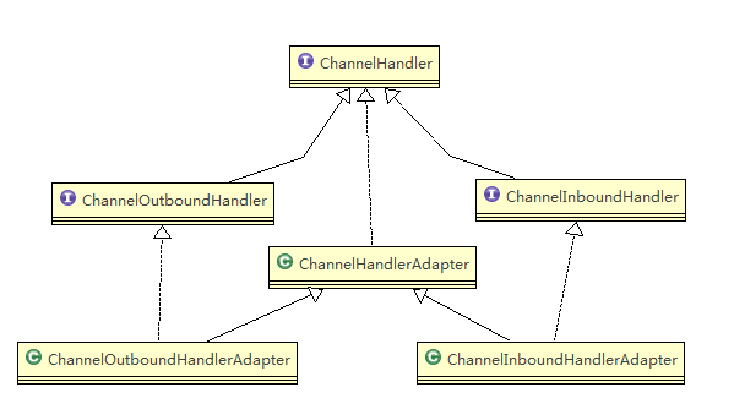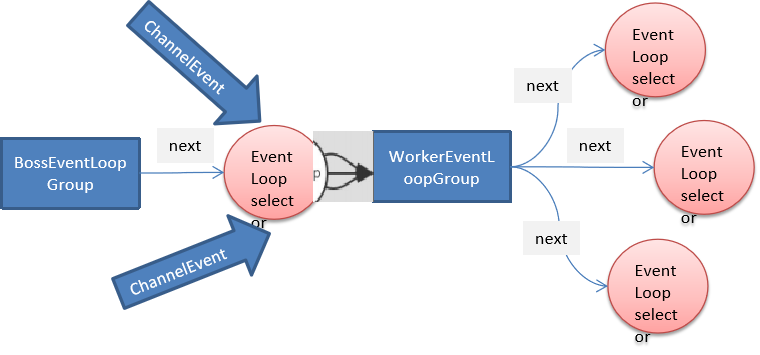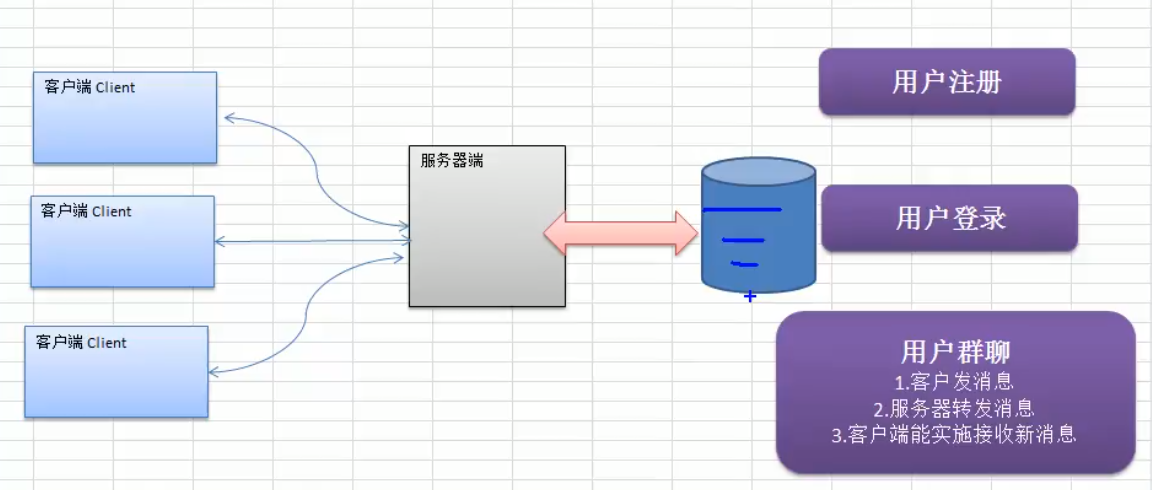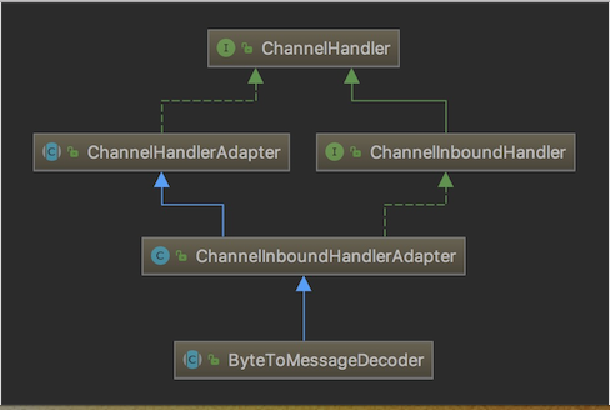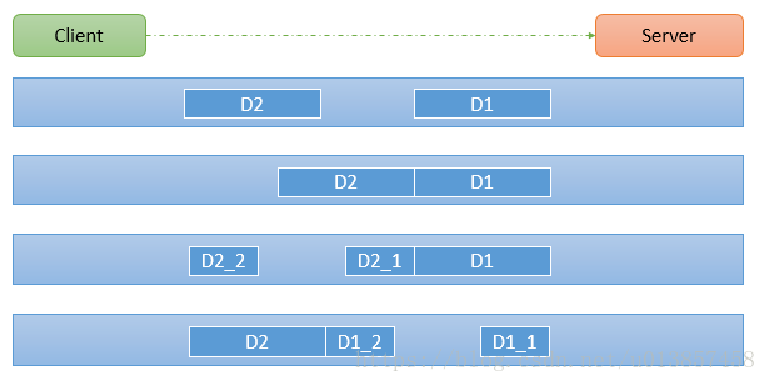Netty 核心模块组件 Bootstrap、ServerBootstrap Bootstrap 意思是引导,一个 Netty 应用通常由一个 Bootstrap 开始 ,主要作用是配置整个 Netty 程序,串联各个组件,Netty 中 Bootstrap 类是客户端程序的启动引导类,ServerBootstrap 是服务端启动引导类
常见的方法有
1 2 3 4 5 6 7 8 9 public ServerBootstrap group (EventLoopGroup parentGroup, EventLoopGroup childGroup) ,该方法用于服务器端,用来设置两个 EventLooppublic B group (EventLoopGroup group) ,该方法用于客户端,用来设置一个 EventLooppublic B channel (Class<? extends C> channelClass) ,该方法用来设置一个服务器端的通道实现public <T> B option (ChannelOption<T> option, T value) ,用来给 ServerChannel 添加配置 y 用来设置bossGroup的通道 public <T> ServerBootstrap childOption (ChannelOption<T> childOption, T value) ,用来给接收到的通道添加配置 设置workGroup的通道public ServerBootstrap childHandler (ChannelHandler childHandler) ,该方法用来设置业务处理类(自定义的 handler)public ChannelFuture bind (int inetPort) ,该方法用于服务器端,用来设置占用的端口号public ChannelFuture connect (String inetHost, int inetPort) ,该方法用于客户端,用来连接服务器端
.handler 对应bossGroup
.childHandler对应workGroup
Future、ChannelFuture Netty 中所有的 IO 操作都是异步的,不能立刻得知消息是否被正确处理。但是可以过一会等它执行完成或者直接注册一个监听,具体的实现就是通过 Future 和 ChannelFutures,他们可以注册一个监听,当操作执行成功或失败时监听会自动触发注册的监听事件
1 2 Channel channel () ,返回当前正在进行 IO 操作的通道 ChannelFuture sync () ,等待异步操作执行完毕,把异步变成同步
Channel
Netty 网络通信的组件,能够用于执行网络 I/O 操作。
通过Channel 可获得当前网络连接的通道的状态
通过Channel 可获得 网络连接的配置参数 (例如接收缓冲区大小)
Channel 提供异步的网络 I/O 操作(如建立连接,读写,绑定端口),异步调用意味着任何 I/O 调用都将立即返回,并且不保证在调用结束时所请求的 I/O 操作已完成
调用立即返回一个 ChannelFuture 实例,通过注册监听器到 ChannelFuture 上,可以 I/O 操作成功、失败或取消时回调通知调用方
1 2 3 4 5 NioSocketChannel,异步的客户端 TCP Socket 连接。 NioServerSocketChannel,异步的服务器端 TCP Socket 连接。 NioDatagramChannel,异步的 UDP 连接。 NioSctpChannel,异步的客户端 Sctp 连接。 NioSctpServerChannel,异步的 Sctp 服务器端连接,这些通道涵盖了 UDP 和 TCP 网络 IO 以及文件 IO。
Selector Netty 基于 Selector 对象实现 I/O 多路复用,通过 Selector 一个线程可以监听多个连接的 Channel 事件。
ChannelHandler ChannelHandler 是一个接口,处理 I/O 事件或拦截 I/O 操作,并将其转发到其 ChannelPipeline(业务处理链)中的下一个处理程序。
1 2 3 4 5 6 7 ChannelInboundHandler 用于处理入站 I/O 事件。 ChannelOutboundHandler 用于处理出站 I/O 操作。 ChannelInboundHandlerAdapter 用于处理入站 I/O 事件。 ChannelOutboundHandlerAdapter 用于处理出站 I/O 操作。 ChannelDuplexHandler 用于处理入站和出站事件。
相对于客户端为例
事件的运动方向是客户端到服务器端,出站
我们经常需要自定义一个 Handler 类去继承 ChannelInboundHandlerAdapter,然后通过重写相应方法实现业务逻辑,我们接下来看看一般都需要重写哪些方法
1 2 3 4 5 6 7 8 9 10 11 12 13 14 15 16 public class ChannelInboundHandlerAdapter extends ChannelHandlerAdapter implements ChannelInboundHandler public ChannelInboundHandlerAdapter () public void channelRegistered (ChannelHandlerContext ctx) throws Exception public void channelUnregistered (ChannelHandlerContext ctx) throws Exception public void channelActive (ChannelHandlerContext ctx) throws Exception public void channelInactive (ChannelHandlerContext ctx) throws Exception public void channelRead (ChannelHandlerContext ctx, Object msg) throws Exception public void channelReadComplete (ChannelHandlerContext ctx) throws Exception public void userEventTriggered (ChannelHandlerContext ctx, Object evt) throws Exception public void channelWritabilityChanged (ChannelHandlerContext ctx) throws Exception public void exceptionCaught (ChannelHandlerContext ctx, Throwable cause) throws Exception
Pipeline 和 ChannelPipeline ChannelPipeline 是一个 Handler 的集合,它负责处理和拦截 inbound 或者 outbound 的事件和操作 ,相当于一个贯穿 Netty 的链。(也可以这样理解:ChannelPipeline 是 保存 ChannelHandler 的 List,用于处理或拦截 Channel 的入站事件和出站操作)
每个 Channel 都有且仅有一个 ChannelPipeline 与之对应
一个 Channel 包含了一个 ChannelPipeline,而 ChannelPipeline 中又维护了一个由 ChannelHandlerContext 组成的双向链表,并且每个 ChannelHandlerContext 中又关联着一个 ChannelHandler
入站事件和出站事件在一个双向链表中,入站事件会从链表 head 往后传递到最后一个入站的 handler,出站事件会从链表 tail 往前传递到最前一个出站的 handler,两种类型的 handler 互不干扰
1 2 ChannelPipeline addFirst (ChannelHandler... handlers) ,把一个业务处理类(handler)添加到链中的第一个位置 ChannelPipeline addLast (ChannelHandler... handlers) ,把一个业务处理类(handler)添加到链中的最后一个位置
ChannelHandlerContext 保存 Channel 相关的所有上下文信息,同时关联一个 ChannelHandler 对象
1 2 3 4 ChannelFuture close () ,关闭通道 ChannelOutboundInvoker flush () ,刷新 ChannelFuture writeAndFlush (Object msg) , 将 数 据 写 到 ChannelPipeline 中 当 前 ChannelHandler 的下一个 ChannelHandler 开始处理(出站)
ChannelOption Netty 在创建 Channel 实例后,一般都需要设置 ChannelOption 参数。
1 2 3 4 5 6 7 8 ChannelOption.SO_BACKLOG 对应 TCP/IP 协议 listen 函数中的 backlog 参数,用来初始化服务器可连接队列大小。服 务端处理客户端连接请求是顺序处理的,所以同一时间只能处理一个客户端连接。多个客户 端来的时候,服务端将不能处理的客户端连接请求放在队列中等待处理,backlog 参数指定 了队列的大小。 ChannelOption.SO_KEEPALIVE 一直保持连接活动状态
EventLoopGroup 和其实现类 NioEventLoopGroup EventLoopGroup 是一组 EventLoop 的抽象,Netty 为了更好的利用多核 CPU 资源,一般会有多个 EventLoop 同时工作,每个 EventLoop 维护着一个 Selector 实例。
EventLoopGroup 提供 next 接口,可以从组里面按照一定规则获取其中一个 EventLoop来处理任务。在 Netty 服务器端编程中,我们一般都需要提供两个 EventLoopGroup,例如:BossEventLoopGroup 和 WorkerEventLoopGroup。
服务端口即一个 ServerSocketChannel对应一个Selector 和一个EventLoop线程。 BossEventLoop 负责接收客户端的连接并将 SocketChannel 交给 WorkerEventLoopGroup 来进行 IO 处理,如下图所示
1 2 3 1. BossEventLoopGroup 通常是一个单线程的 EventLoop,EventLoop 维护着一个注册了ServerSocketChannel 的 Selector 实例BossEventLoop 不断轮询 Selector 将连接事件分离出来 2. 通常是 OP_ACCEPT 事件,然后将接收到的 SocketChannel 交给 WorkerEventLoopGroup 3. WorkerEventLoopGroup 会由 next 选择其中一个 EventLoop来将这个 SocketChannel 注册到其维护的 Selector 并对其后续的 IO 事件进行处理
1 2 public NioEventLoopGroup () ,构造方法public Future<?> shutdownGracefully () ,断开连接,关闭线程
Unpooled 类 Netty 提供一个专门用来操作缓冲区(即Netty的数据容器)的工具类
通过给定的数据和字符编码返回一个 ByteBuf 对象(类似于 NIO 中的 ByteBuffer 但有区别)
1 2 3 4 5 6 7 8 9 10 11 12 13 14 15 16 17 18 19 20 21 22 23 24 25 ByteBuf buffer = Unpooled.buffer(10 ); for (int i = 0 ; i < 10 ; i++) { buffer.writeByte(i); } System.out.println("capacity=" + buffer.capacity()); for (int i = 0 ; i < buffer.capacity(); i++) { System.out.println(buffer.readByte()); } System.out.println("执行完毕" ); }
1 2 3 4 5 6 7 8 9 10 11 12 13 14 15 16 17 18 19 20 21 22 23 24 25 26 27 28 29 30 31 32 33 34 35 ByteBuf byteBuf = Unpooled.copiedBuffer("hello,world!" , Charset.forName("utf-8" )); if (byteBuf.hasArray()) { byte [] content = byteBuf.array(); System.out.println(new String(content, Charset.forName("utf-8" ))); System.out.println("byteBuf=" + byteBuf); System.out.println(byteBuf.arrayOffset()); System.out.println(byteBuf.readerIndex()); System.out.println(byteBuf.writerIndex()); System.out.println(byteBuf.capacity()); System.out.println(byteBuf.getByte(0 )); int len = byteBuf.readableBytes(); System.out.println("len=" + len); for (int i = 0 ; i < len; i++) { System.out.println((char ) byteBuf.getByte(i)); } System.out.println(byteBuf.getCharSequence(0 , 4 , Charset.forName("utf-8" ))); System.out.println(byteBuf.getCharSequence(4 , 6 , Charset.forName("utf-8" ))); } } }
Netty群聊系统
编写一个 Netty 群聊系统,实现服务器端和客户端之间的数据简单通讯(非阻塞)
实现多人群聊
服务器端:可以监测用户上线,离线,并实现消息转发功能
客户端:通过channel 可以无阻塞发送消息给其它所有用户,同时可以接受其它用户发送的消息(有服务器转发得到)
服务器
1 2 3 4 5 6 7 8 9 10 11 12 13 14 15 16 17 18 19 20 21 22 23 24 25 26 27 28 29 30 31 32 33 34 35 36 37 38 39 40 41 42 43 44 45 46 47 48 49 50 51 52 53 54 public class GroupChatServer private int port; public GroupChatServer (int port) this .port = port; } public void run () throws InterruptedException NioEventLoopGroup bossGroup = new NioEventLoopGroup(1 ); NioEventLoopGroup workGroup = new NioEventLoopGroup(); try { ServerBootstrap bootstrap = new ServerBootstrap(); bootstrap.group(bossGroup,workGroup) .channel(NioServerSocketChannel.class) .option(ChannelOption.SO_BACKLOG,128 ) .childOption(ChannelOption.SO_KEEPALIVE,true ) .childHandler(new ChannelInitializer<SocketChannel>() { protected void initChannel (SocketChannel ch) throws Exception ChannelPipeline pipeline = ch.pipeline(); pipeline.addLast("decoder" ,new StringDecoder()); pipeline.addLast("encoder" ,new StringEncoder()); pipeline.addLast(new GroupChatServerHandler()); } }); System.out.println("netty 服务器启动" ); ChannelFuture channelFuture = bootstrap.bind(port).sync(); channelFuture.channel().closeFuture().sync(); }finally { bossGroup.shutdownGracefully(); workGroup.shutdownGracefully(); } } public static void main (String[] args) throws InterruptedException new GroupChatServer(7000 ).run(); } }
1 2 3 4 5 6 7 8 9 10 11 12 13 14 15 16 17 18 19 20 21 22 23 24 25 26 27 28 29 30 31 32 33 34 35 36 37 38 39 40 41 42 43 44 45 46 47 48 49 50 51 52 53 54 55 56 57 58 59 60 61 62 public class GroupChatServerHandler extends SimpleChannelInboundHandler <String > private static ChannelGroup channelGroup = new DefaultChannelGroup(GlobalEventExecutor.INSTANCE); SimpleDateFormat sdf = new SimpleDateFormat("yyyy-MMM-dd HHH:mm:ss" ); @Override public void handlerAdded (ChannelHandlerContext ctx) throws Exception Channel channel = ctx.channel(); channelGroup.writeAndFlush("[客户端]" + channel.remoteAddress()+"加入聊天" +sdf.format(new java.util.Date())); channelGroup.add(channel); } @Override public void channelActive (ChannelHandlerContext ctx) throws Exception System.out.println(ctx.channel().remoteAddress()+"上线了~" ); } @Override public void channelInactive (ChannelHandlerContext ctx) throws Exception System.out.println(ctx.channel().remoteAddress()+"离线了~" ); } @Override public void handlerRemoved (ChannelHandlerContext ctx) throws Exception Channel channel = ctx.channel(); channelGroup.writeAndFlush("[客户端]" + channel.remoteAddress()+"离开了\n" ); System.out.println("channelGroup size=" + channelGroup.size()); } @Override protected void channelRead0 (ChannelHandlerContext ctx, String msg) throws Exception Channel channel = ctx.channel(); channelGroup.forEach(ch->{ if (channel != ch ){ ch.writeAndFlush("[客户]" + channel.remoteAddress()+"发送了消息:" +msg+"\n" ); }else { ch.writeAndFlush("[自己]发送了消息:" +msg+"\n" ); } }); } @Override public void exceptionCaught (ChannelHandlerContext ctx, Throwable cause) throws Exception ctx.close(); } }
客户端
1 2 3 4 5 6 7 8 9 10 11 12 13 14 15 16 17 18 19 20 21 22 23 24 25 26 27 28 29 30 31 32 33 34 35 36 37 38 39 40 41 42 43 44 45 46 47 48 49 50 51 52 import java.util.Scanner;public class GroupChatClient private final String host; private final int port; public GroupChatClient (String host, int port) this .host = host; this .port = port; } public void run () EventLoopGroup group = new NioEventLoopGroup(); try { Bootstrap bootstrap = new Bootstrap(); bootstrap.group(group) .channel(NioSocketChannel.class) .handler(new ChannelInitializer<SocketChannel>() { @Override protected void initChannel (SocketChannel ch) throws Exception ChannelPipeline pipeline = ch.pipeline(); pipeline.addLast("decoder" ,new StringDecoder()); pipeline.addLast("encoder" ,new StringEncoder()); pipeline.addLast(new GroupChatClientHandler()); } }); ChannelFuture channelFuture = bootstrap.connect(host, port).sync(); Channel channel = channelFuture.channel(); System.out.println("-------------" +channel.localAddress()+"--------------" ); Scanner scanner = new Scanner(System.in); while (scanner.hasNextLine()){ String msg = scanner.nextLine(); channel.writeAndFlush(msg+"\r\n" ); } } catch (InterruptedException e) { e.printStackTrace(); } finally { group.shutdownGracefully(); } } public static void main (String[] args) new GroupChatClient("127.0.0.1" ,7000 ).run(); } }
1 2 3 4 5 6 7 public class GroupChatClientHandler extends SimpleChannelInboundHandler <String > @Override protected void channelRead0 (ChannelHandlerContext ctx, String msg) throws Exception System.out.println(msg.trim()); } }
提升方法:单对单
1 2 public static Map<String,Channel> channelHashMap= new ConcurrentHashMap<>();
Netty心跳检测机制案例 当服务器超过3秒没有读时,就提示读空闲
用来检测客户端在不知道的情况下出现了异常,服务器不知道,保证存活
1 2 3 4 5 6 7 8 9 10 11 12 13 14 15 16 17 18 19 20 21 22 23 24 25 26 27 28 29 30 31 32 33 34 35 36 37 38 39 40 41 42 43 44 45 46 47 48 49 50 51 52 53 54 55 public class MyServer public static void main (String[] args) NioEventLoopGroup bossGroup = new NioEventLoopGroup(1 ); NioEventLoopGroup workGroup = new NioEventLoopGroup(); try { ServerBootstrap bootstrap = new ServerBootstrap(); bootstrap.group(bossGroup,workGroup) .channel(NioServerSocketChannel.class) .handler(new LoggingHandler(LogLevel.INFO)) .childHandler(new ChannelInitializer<SocketChannel>() { protected void initChannel (SocketChannel ch) throws Exception ChannelPipeline pipeline = ch.pipeline(); pipeline.addLast(new IdleStateHandler(3 ,5 ,7 , TimeUnit.SECONDS)); pipeline.addLast(new MyServerHandler()); } }); System.out.println("netty 服务器启动" ); ChannelFuture channelFuture = bootstrap.bind(7000 ).sync(); channelFuture.channel().closeFuture().sync(); } catch (InterruptedException e) { e.printStackTrace(); } finally { bossGroup.shutdownGracefully(); workGroup.shutdownGracefully(); } } }
1 2 3 4 5 6 7 8 9 10 11 12 13 14 15 16 17 18 19 20 21 22 23 24 25 26 27 28 29 30 public class MyServerHandler extends ChannelInboundHandlerAdapter @Override public void userEventTriggered (ChannelHandlerContext ctx, Object evt) throws Exception if (evt instanceof IdleStateEvent){ IdleStateEvent event = (IdleStateEvent) evt; String eventType = null ; switch (event.state()){ case READER_IDLE: eventType = "读空闲" ; break ; case WRITER_IDLE: eventType = "写空闲" ; break ; case ALL_IDLE: eventType = "读写空闲" ; break ; } System.out.println(ctx.channel().remoteAddress()+"---超时事件是:" +eventType); } } }
WebSocket编程 Netty 通过WebSocket编程实现服务器和客户端长连接
Http协议是无状态的, 浏览器和服务器间的请求响应一次,下一次会重新创建连接.
要求:实现基于webSocket的长连接的全双工的交互
改变Http协议多次请求的约束,实现长连接了, 服务器可以发送消息给浏览器
客户端浏览器和服务器端会相互感知,比如服务器关闭了,浏览器会感知,同样浏览器关闭了,服务器会感知
1 2 3 4 5 6 7 8 9 10 11 12 13 14 15 16 17 18 19 20 21 22 23 24 25 26 27 28 29 30 31 32 33 34 35 36 37 38 39 40 41 42 43 44 45 46 47 48 49 50 51 52 53 54 55 56 57 58 public class MyServer public static void main (String[] args) NioEventLoopGroup bossGroup = new NioEventLoopGroup(1 ); NioEventLoopGroup workGroup = new NioEventLoopGroup(); try { ServerBootstrap bootstrap = new ServerBootstrap(); bootstrap.group(bossGroup,workGroup) .channel(NioServerSocketChannel.class) .handler(new LoggingHandler(LogLevel.INFO)) .childHandler(new ChannelInitializer<SocketChannel>() { protected void initChannel (SocketChannel ch) throws Exception ChannelPipeline pipeline = ch.pipeline(); pipeline.addLast(new HttpServerCodec()); pipeline.addLast(new ChunkedWriteHandler()); pipeline.addLast(new HttpObjectAggregator(8192 )); pipeline.addLast(new WebSocketServerProtocolHandler("/hello" )); pipeline.addLast(new MyTestWebSocketFrameHandler()); } }); System.out.println("netty 服务器启动" ); ChannelFuture channelFuture = bootstrap.bind(7000 ).sync(); channelFuture.channel().closeFuture().sync(); } catch (InterruptedException e) { e.printStackTrace(); } finally { bossGroup.shutdownGracefully(); workGroup.shutdownGracefully(); } } }
1 2 3 4 5 6 7 8 9 10 11 12 13 14 15 16 17 18 19 20 21 22 23 24 25 26 27 28 29 30 31 32 public class MyTestWebSocketFrameHandler extends SimpleChannelInboundHandler <TextWebSocketFrame > @Override public void handlerAdded (ChannelHandlerContext ctx) throws Exception System.out.println("handlerAdded 被调用" + ctx.channel().id().asLongText()); } @Override public void handlerRemoved (ChannelHandlerContext ctx) throws Exception System.out.println("handlerRemoved 被调用" + ctx.channel().id().asLongText()); } @Override public void exceptionCaught (ChannelHandlerContext ctx, Throwable cause) throws Exception System.out.println("异常发生" +cause.getMessage()); ctx.close(); } @Override protected void channelRead0 (ChannelHandlerContext ctx, TextWebSocketFrame msg) throws Exception System.out.println("服务器收到消息 " +msg.text()); ctx.channel().writeAndFlush(new TextWebSocketFrame("服务器时间" + LocalDateTime.now()+" 返回" +msg.text())); } }
1 2 3 4 5 6 7 8 9 10 11 12 13 14 15 16 17 18 19 20 21 22 23 24 25 26 27 28 29 30 31 32 33 34 35 36 37 38 39 40 41 42 43 44 45 46 47 48 49 50 51 52 53 54 55 56 <!DOCTYPE html > <html lang ="en" > <head > <meta charset ="UTF-8" > <title > Title</title > </head > <body > <script > var socket; if (window .WebSocket) { socket = new WebSocket("ws://localhost:7000/hello" ); socket.onmessage = function (ev ) var rt = document .getElementById("responseText" ); rt.value = rt.value + "\n" + ev.data; } socket.onopen = function (ev ) var rt = document .getElementById("responseText" ); rt.value = "连接开启了.." } socket.onclose = function (ev ) var rt = document .getElementById("responseText" ); rt.value = rt.value + "\n" + "连接关闭了.." } } else { alert("当前浏览器不支持websocket" ) } function send (message ) if (!window .socket) { return ; } if (socket.readyState == WebSocket.OPEN) { socket.send(message) } else { alert("连接没有开启" ); } } </script > <form onsubmit ="return false" > <textarea name ="message" style ="height: 300px; width: 300px" > </textarea > <input type ="button" value ="发生消息" onclick ="send(this.form.message.value)" > <textarea id ="responseText" style ="height: 300px; width: 300px" > </textarea > <input type ="button" value ="清空内容" onclick ="document.getElementById('responseText').value=''" > </form > </body > </html >
编码和解码 编写网络应用程序时,因为数据在网络中传输的都是二进制字节码数据,在发送数据时就需要编码,接收数据时就需要解码
codec(编解码器) 的组成部分有两个:decoder(解码器)和 encoder(编码器)。encoder 负责把业务数据转换成字节码数据,decoder 负责把字节码数据转换成业务数据
Netty 提供的编码器
StringEncoder,对字符串数据进行编码
ObjectEncoder,对 Java 对象进行编码
Netty 提供的解码器
Netty 本身自带的 ObjectDecoder 和 ObjectEncoder 可以用来实现 POJO 对象或各种业务对象的编码和解码,底层使用的仍是 Java 序列化技术 , 而Java 序列化技术本身效率就不高
存在如下问题
Protobuf Google Protocol Buffers,是一种轻便高效的结构化数据存储格式,可以用于结构化数据串行化,或者说序列化。它很适合做数据存储或 RPC[远程过程调用 remote procedure call ] 数据交换格式 。
http+json tcp+protobuf
使用 protobuf 编译器能自动生成代码,Protobuf 是将类的定义使用.proto 文件进行描述。说明,在idea 中编写 .proto 文件时,会自动提示是否下载 .ptotot 编写插件. 可以让语法高亮。
入门 客户端可以发送一个Student PoJo 对象到服务器 (通过 Protobuf 编码)
1.导入坐标
1 2 3 4 5 <dependency > <groupId > com.google.protobuf</groupId > <artifactId > protobuf-java</artifactId > <version > 3.6.1</version > </dependency >
Netty编解码器和handler的调用机制 netty的组件设计:Netty的主要组件有Channel、EventLoop、ChannelFuture、ChannelHandler、ChannelPipe等
ChannelHandler充当了处理入站和出站数据的应用程序逻辑的容器。例如,实现ChannelInboundHandler接口(或ChannelInboundHandlerAdapter),你就可以接收入站事件和数据,这些数据会被业务逻辑处理。当要给客户端发送响应时,也可以从ChannelInboundHandler冲刷数据。业务逻辑通常写在一个或者多个ChannelInboundHandler中。ChannelOutboundHandler原理一样,只不过它是用来处理出站数据的
ChannelPipeline提供了ChannelHandler链的容器。以客户端应用程序为例,如果事件的运动方向是从客户端到服务端的,那么我们称这些事件为出站的,即客户端发送给服务端的数据会通过pipeline中的一系列ChannelOutboundHandler,并被这些Handler处理, 反之则称为入站的
出站和入站是对应不同端的
编码解码器 当Netty发送或者接受一个消息的时候,就将会发生一次数据转换。入站消息会被解码:从字节转换为另一种格式(比如java对象);如果是出站消息,它会被编码成字节。
Netty提供一系列实用的编解码器,他们都实现了ChannelInboundHadnler或者ChannelOutboundHandler 接口。在这些类中,channelRead方法已经被重写了。以入站为例,对于每个从入站Channel读取的消息,这个方法会被调用。随后,它将调用由解码器所提供的decode()方法进行解码,并将已经解码的字节转发给ChannelPipeline中的下一个ChannelInboundHandler。
ByteToMessageDecoder解码器
1 2 3 4 5 6 7 8 public class ToIntegerDecoder extends ByteToMessageDecoder @Override protected void decode (ChannelHandlerContext ctx, ByteBuf in, List<Object> out) throws Exception if (in.readableBytes() >= 4 ) { out.add(in.readInt()); } } }
每次入站从ByteBuf中读取4字节,将其解码为一个int,然后将它添加到下一个List中。当没有更多元素可以被添加到该List中时,它的内容将会被发送给下一个ChannelInboundHandler。int在被添加到List中时,会被自动装箱为Integer。在调用readInt()方法前必须验证所输入的ByteBuf是否具有足够的数据
Netty的handler链的调用机制 使用自定义的编码器和解码器来说明Netty的handler 调用机制
解码器:
1 2 3 4 5 6 7 8 9 10 11 12 13 14 15 16 17 18 public class MyByteToLongDecoder extends ByteToMessageDecoder @Override protected void decode (ChannelHandlerContext ctx, ByteBuf in, List<Object> out) throws Exception System.out.println("decode调用" ); if (in.readableBytes() >= 8 ){ out.add(in.readLong()); } } }
编码器:
1 2 3 4 5 6 7 8 9 10 public class MyLongToByteEncoder extends MessageToByteEncoder <Long > @Override protected void encode (ChannelHandlerContext ctx, Long msg, ByteBuf out) throws Exception System.out.println(" MyLongToByteEncoder encode 被调用" ); System.out.println("msg = " +msg); out.writeLong(msg); } }
服务器:
1 2 3 4 5 6 7 8 9 10 11 12 13 14 15 16 17 18 19 20 21 22 23 24 25 26 27 28 29 30 31 public class MyServer public static void main (String[] args) throws InterruptedException NioEventLoopGroup bossGroup = new NioEventLoopGroup(); NioEventLoopGroup workGroup = new NioEventLoopGroup(); try { ServerBootstrap bootstrap = new ServerBootstrap(); bootstrap.group(bossGroup,workGroup) .channel(NioServerSocketChannel.class) .childHandler(new MyServerInitializer()); System.out.println("服务器 is ready" ); ChannelFuture cf = bootstrap.bind(7000 ).sync(); cf.channel().closeFuture().sync(); }finally { bossGroup.shutdownGracefully(); workGroup.shutdownGracefully(); } } }
服务端处理器
1 2 3 4 5 6 7 8 9 10 11 12 13 14 15 16 17 public class MyServerInitializer extends ChannelInitializer <SocketChannel > @Override protected void initChannel (SocketChannel ch) throws Exception ChannelPipeline pipeline = ch.pipeline(); pipeline.addLast(new MyByteToLongDecoder()); pipeline.addLast(new MyLongToByteEncoder()); pipeline.addLast(new MyServerHandler()); } }
服务器业务处理
1 2 3 4 5 6 7 8 9 10 11 12 13 14 15 public class MyServerHandler extends SimpleChannelInboundHandler <Long > @Override protected void channelRead0 (ChannelHandlerContext ctx, Long msg) throws Exception System.out.println("从客户端读取到" +ctx.channel().remoteAddress()+"读取到long:" +msg); ctx.writeAndFlush(98765L ); } @Override public void exceptionCaught (ChannelHandlerContext ctx, Throwable cause) throws Exception cause.printStackTrace(); ctx.close(); } }
客户端:
1 2 3 4 5 6 7 8 9 10 11 12 13 14 15 16 17 18 19 20 21 22 23 24 25 26 public class NettyClient public static void main (String[] args) throws InterruptedException NioEventLoopGroup eventExecutors = new NioEventLoopGroup(); try { Bootstrap bootstrap = new Bootstrap(); bootstrap.group(eventExecutors) .channel(NioSocketChannel.class) .handler(new MyClientInitializer()); System.out.println("客户端 ok.." ); ChannelFuture channelFuture = bootstrap.connect("127.0.0.1" , 7000 ).sync(); channelFuture.channel().closeFuture().sync(); }finally { eventExecutors.shutdownGracefully(); } } }
客户端处理器链:
1 2 3 4 5 6 7 8 9 10 11 12 13 14 public class MyClientInitializer extends ChannelInitializer <SocketChannel > @Override protected void initChannel (SocketChannel ch) throws Exception ChannelPipeline pipeline = ch.pipeline(); pipeline.addLast(new MyLongToByteEncoder()); pipeline.addLast(new MyByteToLongDecoder()); pipeline.addLast(new MyClientHandler()); } }
客户端业务处理:
1 2 3 4 5 6 7 8 9 10 11 12 13 14 15 16 17 18 19 20 21 22 23 24 25 26 27 28 29 30 31 32 33 34 35 36 37 38 39 40 41 42 43 44 45 46 47 48 49 50 51 52 53 54 55 56 57 58 59 60 61 public class MyClientHandler extends SimpleChannelInboundHandler <Long > @Override protected void channelRead0 (ChannelHandlerContext ctx, Long msg) throws Exception System.out.println("得到服务器ip=" +ctx.channel().remoteAddress()+":收到的消息为" +msg); } @Override public void channelActive (ChannelHandlerContext ctx) throws Exception System.out.println("MyClientHandler 发送数据" ); ctx.writeAndFlush(12345L ); } @Override public void exceptionCaught (ChannelHandlerContext ctx, Throwable cause) throws Exception cause.printStackTrace(); ctx.close(); } }
不论解码器handler 还是 编码器handler 即接收的消息类型必须与待处理的消息类型一致,否则该handler不会被执行
在解码器 进行数据解码时,需要判断 缓存区(ByteBuf)的数据是否足够 ,否则接收到的结果会期望结果可能不一致
解码器-ReplayingDecoder public abstract class ReplayingDecoder<S> extends ByteToMessageDecoder
ReplayingDecoder扩展了ByteToMessageDecoder类,使用这个类,我们不必调用readableBytes()方法 。参数S指定了用户状态管理的类型,其中Void代表不需要状态管理
并不是所有的 ByteBuf 操作都被支持,如果调用了一个不被支持的方法,将会抛出一个 UnsupportedOperationException。
ReplayingDecoder 在某些情况下可能稍慢于 ByteToMessageDecoder,例如网络缓慢并且消息格式复杂时,消息会被拆成了多个碎片,速度变慢
TCP 粘包和拆包 TCP是面向连接的,面向流的,提供高可靠性服务 。收发两端(客户端和服务器端)都要有一一成对的socket,因此,发送端为了将多个发给接收端的包,更有效的发给对方,使用了优化方法(Nagle算法),将多次间隔较小且数据量小的数据,合并成一个大的数据块,然后进行封包。 这样做虽然提高了效率,但是接收端就难于分辨出完整的数据包了,因为面向流的通信是无消息保护边界的
服务端分两次读取到了两个独立的数据包,分别是D1和D2,没有粘包和拆包
服务端一次接受到了两个数据包,D1和D2粘合在一起,称之为TCP粘包
服务端分两次读取到了数据包,第一次读取到了完整的D1包和D2包的部分内容,第二次读取到了D2包的剩余内容,这称之为TCP拆包
服务端分两次读取到了数据包,第一次读取到了D1包的部分内容D1_1,第二次读取到了D1包的剩余部分内容D1_2和完整的D2包。
TCP 粘包和拆包解决方案 使用自定义协议 + 编解码器 来解决服务器端每次读取数据长度的问题, 这个问题解决,就不会出现服务器多读或少读数据的问题,从而避免的TCP 粘包、拆包 。
协议包
1 2 3 4 5 6 7 8 9 10 11 12 13 14 15 16 17 18 19 20 public class MessageProtocol private int len; private byte [] content; public int getLen () return len; } public void setLen (int len) this .len = len; } public byte [] getContent() { return content; } public void setContent (byte [] content) this .content = content; } }
服务器
1 2 3 4 5 6 7 8 9 10 11 12 13 14 15 16 17 18 19 20 21 22 23 24 25 26 27 28 29 30 31 public class MyServer public static void main (String[] args) throws InterruptedException NioEventLoopGroup bossGroup = new NioEventLoopGroup(); NioEventLoopGroup workGroup = new NioEventLoopGroup(); try { ServerBootstrap bootstrap = new ServerBootstrap(); bootstrap.group(bossGroup,workGroup) .channel(NioServerSocketChannel.class) .childHandler(new MyServerInitializer()); System.out.println("服务器 is ready" ); ChannelFuture cf = bootstrap.bind(7000 ).sync(); cf.channel().closeFuture().sync(); }finally { bossGroup.shutdownGracefully(); workGroup.shutdownGracefully(); } } }
1 2 3 4 5 6 7 8 9 10 11 12 13 public class MyServerInitializer extends ChannelInitializer <SocketChannel > @Override protected void initChannel (SocketChannel ch) throws Exception ChannelPipeline pipeline = ch.pipeline(); pipeline.addLast(new MyMessageDecoder()); pipeline.addLast(new MyServerHandler()); } }
1 2 3 4 5 6 7 8 9 10 11 12 13 14 public class MyMessageDecoder extends ReplayingDecoder <Void > @Override protected void decode (ChannelHandlerContext ctx, ByteBuf in, List<Object> out) throws Exception System.out.println("MyMessageDecoder decode 被调用" ); int len = in.readInt(); byte [] content = new byte [len]; in.readBytes(content); MessageProtocol messageProtocol = new MessageProtocol(); messageProtocol.setContent(content); messageProtocol.setLen(len); out.add(messageProtocol); } }
1 2 3 4 5 6 7 8 9 10 11 12 13 14 15 16 17 18 19 20 21 22 23 24 25 26 27 28 29 30 31 32 33 public class MyServerHandler extends SimpleChannelInboundHandler <MessageProtocol > private int count=0 ; @Override public void exceptionCaught (ChannelHandlerContext ctx, Throwable cause) throws Exception cause.printStackTrace(); ctx.close(); } @Override protected void channelRead0 (ChannelHandlerContext ctx, MessageProtocol msg) throws Exception int len = msg.getLen(); byte [] content = msg.getContent(); System.out.println("服务端接收到 " ); System.out.println("长度=" +len); System.out.println("内容=" +new String(content,CharsetUtil.UTF_8)); System.out.println("服务器接收到消息量:" +(++this .count)); } }
客户端:
1 2 3 4 5 6 7 8 9 10 11 12 13 14 15 16 17 18 19 20 21 22 23 24 25 26 public class MyClient public static void main (String[] args) throws InterruptedException NioEventLoopGroup eventExecutors = new NioEventLoopGroup(); try { Bootstrap bootstrap = new Bootstrap(); bootstrap.group(eventExecutors) .channel(NioSocketChannel.class) .handler(new MyClientInitializer()); System.out.println("客户端 ok.." ); ChannelFuture channelFuture = bootstrap.connect("127.0.0.1" , 7000 ).sync(); channelFuture.channel().closeFuture().sync(); }finally { eventExecutors.shutdownGracefully(); } } }
1 2 3 4 5 6 7 8 9 10 public class MyClientInitializer extends ChannelInitializer <SocketChannel > @Override protected void initChannel (SocketChannel ch) throws Exception ChannelPipeline pipeline = ch.pipeline(); pipeline.addLast(new MyMessageEncoder()); pipeline.addLast(new MyClientHandler()); } }
1 2 3 4 5 6 7 8 public class MyMessageEncoder extends MessageToByteEncoder <MessageProtocol > @Override protected void encode (ChannelHandlerContext ctx, MessageProtocol msg, ByteBuf out) throws Exception System.out.println("MyMessageEncoder encode 被调用" ); out.writeInt(msg.getLen()); out.writeBytes(msg.getContent()); } }
1 2 3 4 5 6 7 8 9 10 11 12 13 14 15 16 17 18 19 20 21 22 23 24 25 26 27 28 29 30 31 32 33 34 35 36 37 38 39 40 41 public class MyClientHandler extends SimpleChannelInboundHandler <MessageProtocol > private int count=0 ; @Override public void channelActive (ChannelHandlerContext ctx) throws Exception String msg = "今天天气冷,吃火锅" ; for (int i = 0 ; i < 10 ; i++){ byte [] content = msg.getBytes(Charset.forName("utf-8" )); int len = msg.getBytes(Charset.forName("utf-8" )).length; MessageProtocol messageProtocol = new MessageProtocol(); messageProtocol.setLen(len); messageProtocol.setContent(content); ctx.writeAndFlush(messageProtocol); } } @Override public void exceptionCaught (ChannelHandlerContext ctx, Throwable cause) throws Exception cause.printStackTrace(); ctx.close(); } @Override protected void channelRead0 (ChannelHandlerContext ctx, MessageProtocol msg) throws Exception } }
